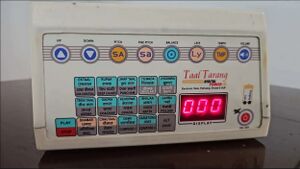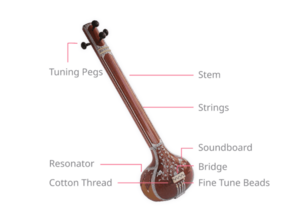PHYS341/2024/Project10
Tanpura
Tanpura or तंबूरा is categorized under the family of plucked stringed instruments and is most vital to Indian classical music. The Tanpura consists of four or five strings attached to the tuning pegs at the end, and these four strings are plucked periodically to create an ambiance and a tonal background for accompanying instruments and vocalists. The Tanpura is also used when practicing classical Indian vocal music. “It is said to help in purifying the ability to produce correct “shrutis” (micro-tonal note positions) by feeling the consonance between the singing and the Tanpura sound.”[1] The short recording below is of a Tanpura set to the C key.[2]
Historical Background
The word Tanpura originates from the words ‘tana,’ which means ‘musical phrase, 'and ‘pura,’ which means ‘complete.’ The history of Tanpura is quite obscure, with multiple scholars debating its origin.[1] However, it is known that Tanpura was called Tumburu Vina in ancient times. Given that “Been or Vina is the origin of all Indian string musical instruments,” the scholars were able to conclude that the Tanpura has a similar history to other stringed instruments that originated around 1500 B.C.E. with its modern shape evolving from the instrument known as Sitar.[1]
With the progress of time, it eventually came to be called Tanpura in the eastern and central parts of India, and other parts of the country, it was called Tambura.[1] From the middle to late 17th century, the affluent members of society used completely wooden Tanpura, while street performers, beggars, and the poor used Tanpura made with gourd. Tanjore became the Tanpura-making centre in South India, and Lucknow and Rampur in North India.[1]
Traditional Postures
Two legitimate and traditional recorded postures are assumed while playing the Tanpura: vertical and horizontal.[1] When played vertically, the base is placed on the lap, besides the lap, or even in front of the lap. It can also be placed on a hay ring called a Bira, it is used in both vertical and horizontal playing positions, in the case of the latter, it is slightly inclined and the neck leans toward the player.[1]
Contemporary Tanpura
Today we recognise 3 main types of traditional Tanpura, The Male, The Female , and The Instrumental type. The Male is by length the longest Tanpura, boasting the thickest strings and the lowest tuning.[3] The Female Tanpura is shorter in length with strings that are thinner as compared to The Male Tanpura, and The Instrumental type also known as the Tanpuri, is about half the length of The Male Tanpura.[3] The soundbox of The Male and The Female Tanpura is made of gourd whereas the Tanpura is constructed entirely out of wood.[3]
In modern times The Tanpura and its players aren't as readily available to everybody, but Indian classical vocalists still require them to practice properly. To fill this need we have The electronic Tanpura box. This small device is approximately the size of your household tissue box, and generates the sound of both The Male and Female Tanpura, and possesses options for adjusting pitch, key, tempo and volume.
In a similar fashion, due to a growing lack of tabla players, vocalists also make sure of an instrument called the Taal Tarang which is an electronic box similar to the electronic Tanpura box. It serves as a substitute to the Tabla, Dholak, Pakhawaj and Duff instruments.

Basic Structures

A Tanpura (see Figure 3) consists of eight primary components: tuning pegs, stem, strings, resonator, soundboard, cotton thread, bridge, and fine-tuned bread.[2] The base of the Tanpura is made out of the dry Gourd shell that functions as a resonator.[2] The Tanpura has four steel or bronze strings attached to the tuning pegs placed at the top and the bridge at the bottom of the instrument.[2] The soundboard and stem of Tanpura are usually made of “Toon” wood, while “Sishu” wood is used for the pegs.[1] The tuning pegs, the fine-tuning beads, and the thread position allow musicians to adjust the pitch to play specific music.[2]
Difference: Sitar and Tanpura
Given their historical origins, Sitar and Tanpura have numerous similarities in the construction of the instrument. Where the only difference between the Sitar and Tanpura is observed in the presence of frets.[4] While frets are necessary for the Sitar, the Tanpura does not require frets, as the steel strings attached to is always plucked at the entire length, making the two instruments distinguishable.[4]
Sizes of Tanpura
Male Tanpura:
The most oversized version of Tanpura is powerful and has the most resonance.[5] It is especially suited for playing low pitches, such as the C key, which is known to best complement the male vocal range. The Male Tanpura is equipped with 4 strings and is about 140-150 cm long.[5]
Female Tanpura:
The size of the Female Tanpura is between the Male and Instrumental Tanpura, with a total length of between 120-130cm.[5] The pitch for the Female Tanpura is suited for the G key, which best suits the vocal range of women.[5]
Instrumental Tanpura:
The Instrumental Tanpura is the smallest version, between 95 and 115 cm in length. The difference between the Male and Female Tanpura is that they are often equipped with a total of 5 strings.[5] Because it is the smallest and most straightforward version of Tanpura, it is usually used as an accompaniment to other instruments.[5]
Physics of Tanpura
The Principles of Superposition and the Fourier's Theorem
Tanpura, similar to the acoustic guitar, follows a specific pattern of overtones. As the Fourier's theorem states, the soundwaves can be expressed by superimposing single frequency waves.[6] When a stretched string in contact with each end is plucked, the string follows the following vibrating patterns (see Figure 4) shown in the image.[2] Although the intensity of the vibrations may differ, showing differences in the spectrum graph, they play all of the pure tones simultaneously (see Figure 5). This phenomenon occurs due to the principles of superpositions, which allow multiple sound waves to travel on the same medium simultaneously without disturbing each other.[7] The most dominant sound is labeled as the “fundamental frequencies,” the rest follows as f2, f3, f4, etc.[2]


Material Composition of the String:
As stated the Tanpura has four steel or bronze string.[1] The steel or bronze string allows higher tension than a typical nylon strings used in a an instrument such as a Classical Guitar.[8] The tension of a string and a frequency has an converse relationship where the increase in tension leads to increase in frequency.[8] This increase in tension accounts for a stronger presence of the fundemental frequencies allowing Tanpura to have more powerful and brigher sound when percieved by human ears.[8]
The First String
The First String is tuned to Pa (Fifth) or Ma to produce a bass sound.[9] It has a thicker string than the other two, which accounts for the sound of the octave.[9]
The Second and Third String
The Second and Third Strings of Tanpura are tuned to Sa (Higher), with the two having an octave relationship of 12 musical notes, allowing the instrument to have rich harmonics.[9]
The Fourth String
The Fourth String is tuned to Sa (lower), with eleven harmonics between the third string.[9]
The Length of the String:
The length of the strings determines the pitch of the sound and they are inversly proportional. For example, the string that is 5mm long has lower pitch than a 4mm string on Tanpura.
Jvari (Bridge)
The Tanpura generates patterns of rich overtones, also known as a Drone effect.[10] This phenomenon in Indian Classical Music is called Jvari, meaning “Life Giving."[10] Jvari is produced when the plucked string vibrates against the “hard oval shaped bridge of the Tanpura.”[10] The average fundamental frequency of the music produced by tanpura is significantly consistent along its progression and the music produced is characterized by a pattern of periodic waxing and waning of the amplitude envelope of each of the other harmonics produced by the tanpura strings.”[10]
References
- ↑ 1.0 1.1 1.2 1.3 1.4 1.5 1.6 1.7 1.8 Datta, Asoke; Sengupta, Ranjan; Banerjee, Kaushik; Ghosh, Dipak (2019). Acoustical Analysis of the Tanpura. Springer. ISBN 978-981-13-2610-3.
- ↑ 2.0 2.1 2.2 2.3 2.4 2.5 2.6 Sadharani. "Tanpura - A Prism for Harmonics".
- ↑ 3.0 3.1 3.2 "Types of present-day tanpuras". tosslevy.nl.
- ↑ 4.0 4.1 "DIFFERENCES BETWEEN SITAR, VEENA AND TANPURA". INDIANMUSICALJOURNEYBLOG. 2016.
- ↑ 5.0 5.1 5.2 5.3 5.4 5.5 "Tanpura". INDIAINSTRUMENTS. Check date values in:
|access-date=(help); Missing or empty|url=(help);|access-date=requires|url=(help) - ↑ "Steady-state waves". Britannica.
- ↑ Raymond, David. "1.4: Superposition Principle". LibreTexts.
- ↑ 8.0 8.1 8.2 "Steel vs. Nylon Strings: What's the Difference?". Strings and Beyond. 2023.
- ↑ 9.0 9.1 9.2 9.3 "Tanpura Tuning". RIYAAZQAWWALI.
- ↑ 10.0 10.1 10.2 10.3 Bhaduri, Susmita; Bhaduri, Anirban; Ghosh, Dipak (2020). Acoustical genesis of uniqueness of tanpura-drone signal—Probing with non-statistical fluctuation pattern. Kolkata. ISBN 0378-4371 Check
|isbn=value: length (help).